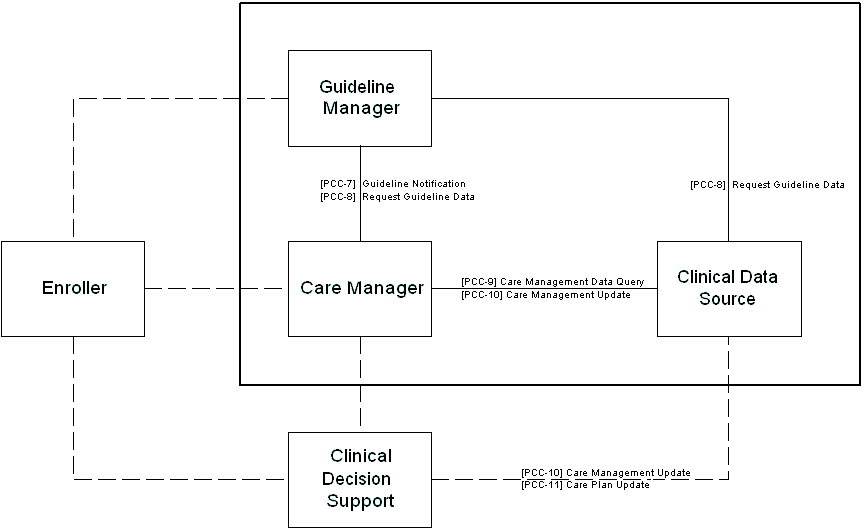Clinical Decision Support
1. Proposed Profile: Clinical Decision Support
- Proposal Editor: Keith W. Boone
- Profile Editor: Keith W. Boone
- Date: N/A (Wiki keeps history)
- Version: N/A (Wiki keeps history)
- Domain: Patient Care Coordination
Summary
Clinical decision support has been difficult to integrate into HIT systems because focus in the past has been on exchange of the clinical decision support algorithm. Even though a wide variety of algorithms exist to solve CDS problems, there is as yet, no uniform way to integrate them into HIT systems.
The HL7 Care Record message provides a way to communicate decision support inputs and outputs between HIT and CDS applications. By utilizing these messages, HIT applications could quickly incorporate CDS capabilities from a variety of sources into different workflows.
Most of the work in profiling the HL7 Care Record standard has already been completed in the Care Management and QED profiles. With a little additional work, new transactions could be developed that would enable CDS to be easily integrated with HIT applications.
2. The Problem
A wide class of problems in healthcare are described as being in the area of clinical decision support. However, integration of these capabilities into EHR applications has been slow due to the inability to integrate clinical decision support into HIT applications.
Most focus on integration of CDS has been in the area of describing the logic that is used to solve the problems. However, the exchange of CDS algorithms has failed to make decision support more readily available.
What is first needed is a common way to integrate CDS into healthcare IT applications to support its use to solve problems such as:
- Drug and Allergy interaction detection
- Forecasting a vaccine schedule
- Identification of patients eligible for participation in reseach or other programs.
- Cost effective selection of antibiotics based on recent institutional data
The key is not in how to express the decision support logic, but to integrate that logic into a healthcare IT application in a standard fashion.
3. Key Use Case
A key use case for this profile will focus on vaccine forecasting, but this profile can be applied to other use cases as well.
In the vaccine forecast use case, patient information about immunizations, allergies, and relevant conditions is first gathered from the EHR. This information is then transmitted to the Vaccine forecast system. That system responds with validated clinical data used for making the forecast, and one or more possible vaccination schedules.
This generalizes to an interchange where clinical data conforming to a template or input specification is gathered, structured in a standard fashion, and then submitted to a decision making system. The decision making system may generate new clinical information (e.g., validated clinical data), and one or more plans for care or treatment proposals (e.g., a vaccination schedule).
4. Standards & Systems
<List relevant standards, where possible giving current version numbers, level of support by system vendors, and references for obtaining detailed information.>
<List systems that could be involved/affected by the profile.>
5. Technical Approach
<This section can be very short but include as much detail as you like. The Technical Committee will flesh it out when doing the effort estimation.>
<Outline how the standards could be used/refined to solve the problems in the Use Cases. The Technical Committee will be responsible for the full design and may choose to take a different approach, but a sample design is a good indication of feasibility.>
<If a phased approach would make sense indicate some logical phases. This may be because standards are evolving, because the problem is too big to solve at once, or because there are unknowns that won’t be resolved soon.>
Existing actors
Clinical Data Source
Clinical Data Consumer
Care Manager
New actors
Clinical Decision Advisor
Existing transactions
PCC-1, PCC-10 and/or PCC-11 Reuse existing transactions of the CM and/or QED profile to send clinical data in a message, and retrieve from it new information or care plans.
New transactions (standards used)
Care Plan Update -- PCC-12
Standards
- HL7 Care Record DSTU
- HL7 Care Plan
- HL7 Continuity of Care Document
- HL7 Vaccine Forecast Functional Service Model
- SNOMED CT
- LOINC
- Templates from PCC-TF
Impact on existing integration profiles
N/A
New integration profiles needed
N/A
Breakdown of tasks that need to be accomplished
Evaluation of PCC-1, PCC-10, PCC-11 and similar transactions to determine what common capabilities are be needed in PCC-12.
6. Support & Resources
GE Healthcare
7. Risks
Coordination with HL7 DOA, PHER, CDS and Care Provision Workgroups
The Care Plan is still in draft state in HL7.
8. Open Issues
- Is the profile dealing with just synchronous queries (question/answer style), or will it also deal with asynchronous issues as well (stateless vs. stateful).
- Is there a way to address stateless/stateful above using composition, and if so, what actor deals with maintenance of state between invocations?
- Is the latter an issue to be addressed in ITI in a subsequent iteration?
<If there are no Open Issues at Evaluation Time, it is usually a sign that the proposal analysis and discussion has been incomplete.>
9. Tech Cmte Evaluation
<The technical committee will use this area to record details of the effort estimation, etc.>
Effort Evaluation (as a % of Tech Cmte Bandwidth):
- 35% for ...
Responses to Issues:
- See italics in Risk and Open Issue sections
Candidate Editor:
- TBA
<Delete this Category Templates line since your specific Profile Proposal page is no longer a template.>
